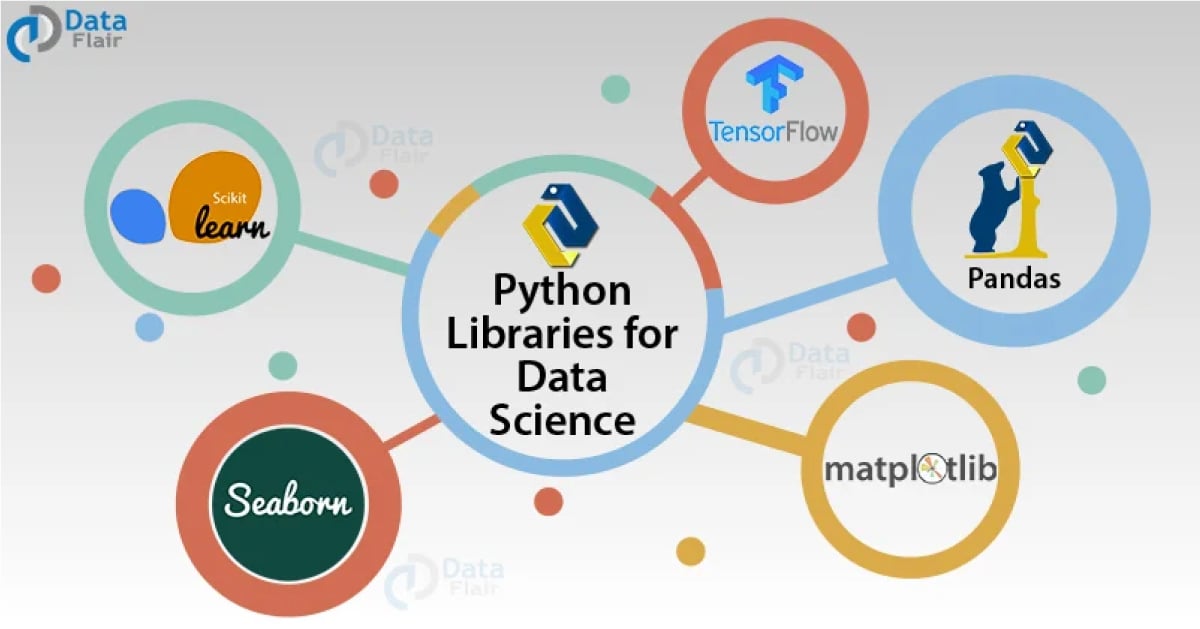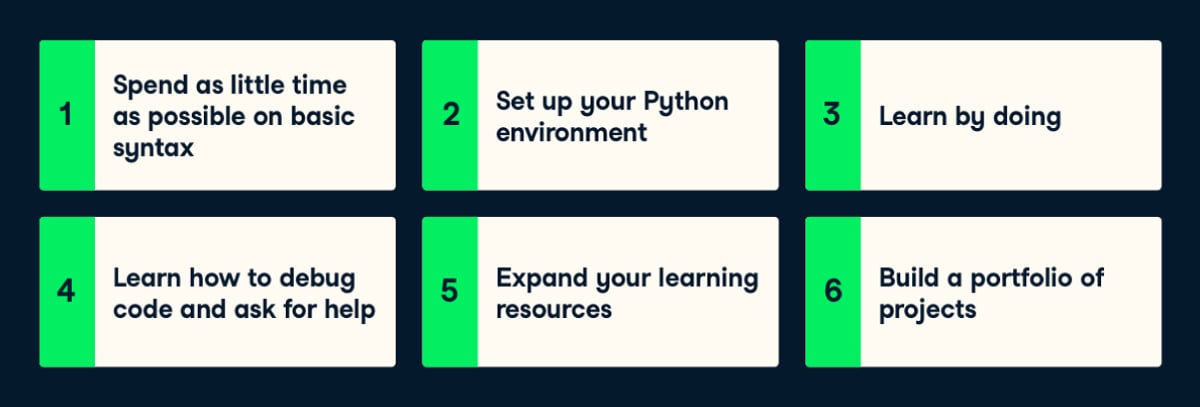What Is Python Used For? 9 Use Cases [Overview Guide]

In this article
Programming is a great career choice for many reasons. And while many will agree that it’s best to start by mastering a single programming language, most don’t agree on which language you should learn first. That’s why we’ve created this guide introducing you to Python, one of the most popular languages. In this guide, we’ll tell you all about Python, what it’s used for, and why many companies use it and seek candidates who are familiar with it.
What Is Python?
Python is a general-purpose programming language that is intuitive to learn. As a high-level, interpreted programming language, it can be read more like plain English. It can be used for anything from web applications, automating redundant tasks, object-oriented programming, machine learning projects, and more.
Why Is Python So Popular?
Python is popular because of its emphasis on plain English and simple syntax. Syntax refers to rules around how the programmer must use the language when writing code. There aren’t as many cryptic symbols you need to worry about, and you can write code easily that makes sense to humans thanks to its high-level nature.
Below, we have two blocks of code that show how to define a function in Python (left) and JavaScript (right). Functions take in inputs (in the below example a and b) and produce outputs (in the below example a and b multiplied together).
Defining a Function:
Python generally requires fewer and simpler symbols. It is also less verbose, which makes it enjoyable to code in. Python also has very helpful line space and line break rules (the return statement is under the definition statement and indented over one). In the JavaScript code block, by contrast, I could have not indented and it would still run. This is just one reason why it’s so popular.
Because Python is a general-purpose language, it has many applications. Coupling its versatility with its easy-to-understand syntax means it’s both powerful and beginner friendly. When a programming language is popular, it also means there is a more active community that is willing to teach and learn how to debug and fix issues, advance methodologies, and more. This, in turn, ensures continued popularity and demand.
With this popularity comes packages built into Python as well. A package is a means of abstracting away some of the details of developing for a particular goal. For example, you actually don’t need to define the function that I screenshotted above, because the NumPy package already has a multiplication function created among many other mathematical functions that people use all the time. With packages, you can work smarter not harder, and only create custom functions you really need to create. The popularity of Python means there are also many frameworks available in Python, which you can think of as systems and boilerplate projects for building a certain type of product like a website. For example, Django is a popular framework for developing fully featured web applications, and it is even used by the likes of Pinterest, Instagram, Spotify, and more.
Related Read: Why Are Python Programmers in Such High Demand
What Is Python Used For?

Source: Net Solution
Here are some of the ways that python is used:
Data Analysis
You can perform all sorts of analyses using Python from basic arithmetic to more complex calculations. If you find yourself repeating your efforts over and over, then you can use Python’s ability to define custom functions. In the previous screenshotted code snippets example, the manipulation was multiplying a and b together, which you get to declare the values of when you run the function. But the magic of Python and its large community is that there are so many packages available to use. NumPy is an example of a package that has many core functions valuable to data analysis such as min, max, mean, standard deviation, and anything else you would expect in a program like Excel. In addition to using NumPy to perform array arithmetic (mathematical operations down a column of data basically), you can also learn about lambda expressions, a super useful operation that comes out of the box in Python.
Related Read: 17 Data Analyst Skills Employers Expect You to Have
Data Science

Data science is the practice of capturing, analyzing, and using data to predict outcomes and derive insights. Python is the most popular programming language for data science, and as such, it has many of the popular packages used in data science.
Related Read: A Full Introduction to Data Science With Python
Get To Know Other Data Science Students
Sam Fisher
Data Science Engineer at Stratyfy
Jonas Cuadrado
Senior Data Scientist at Feedzai
Jasmine Kyung
Senior Operations Engineer at Raytheon Technologies
Machine Learning, Deep Learning, and Artificial Intelligence
Machine learning, artificial intelligence, and deep learning are used to improve product experiences and deliver on business needs in real-time. The ultimate output of work in these areas is usually a predictive model which, usually in real-time, takes in data (generally created out of online users’ behavior) and produces predictions and/or suggestions. An example of machine learning in action is Amazon’s recommended products.
Python is used for all three of these fields, and programmers utilize libraries and frameworks to take some of the redundant work out of getting results. This is because similar problems have been solved by many smart people before.
Related Read: 15 Best Python Libraries for Deep Learning and Machine Learning
Web Development
Python also has many frameworks available for producing fully functional websites and web applications. You could make anything with these frameworks. Examples include Django and Flask, which are the more popular ones. You can combine Python’s excellent ability to perform calculations quickly with one of these frameworks to create a web application that can handle user data and inputs quickly to produce results. An example of this is Uber, which needs to perform ride time, arrival predictions, and make price changes on the fly.
Data Visualization & Scientific Figures
Python also has many excellent data visualization packages that give it powerful graphing capability. If you think visualizations in Excel are good, wait until you see Python-based ones. Seaborn and bokeh are two such examples. Seaborn has many great visualizations, and bokeh is a great option if you want to get into the world of interactive visualizations. You can drag sliders, change input values, colors, and more.
Here are just a few examples from the Seaborn package:

Desktop Graphical User Interfaces (GUIs)
Though cloud-based software has eclipsed GUIs in popularity, there are still GUIs out there that are tied to the cloud (Adobe Creative Cloud and Ableton to name a couple). And even GUIs can be made using Python. If that is your goal or if that is an area you are interested in, then you have this angle from which to learn Python as well.
Game Development
If you are interested in game development, you’d know that the biggest frameworks are Unity and the Unreal engine. But did you know that you can also develop games in Python using PyGame? If you love games and want to build your Python knowledge doing what you love, this framework would allow you to do so.
Real-world Python Use Cases
It should be no surprise that many businesses have taken a liking to Python. Let’s take a look at how some well-known companies employ python:
Amazon

Amazon is heavily driven by machine learning and data science, and Python is the dominant language for creating machine learning models. Amazon has a recommendation engine under the hood that takes in data about your purchases and surfaces products similar to ones you have purchased before.

Python is scalable for web applications, so it can handle lots of traffic and information (in the form of photos being sent and received in this case), making it perfect for Instagram’s needs. Instagram also uses python to suggest content you’ll like, just as Amazon does.
Uber

Uber uses Python’s fast calculation times in order to produce real-time price fluctuations based on ride demand and driver supply, calculate totals and arrival times based on destination and origin, and more. Uber Eats uses similar complex and quick calculations to suggest add-ons to your order.
How To Get Started Learning and Using Python

If that all sounds exciting to you, and you want to learn how to use Python, then check out these tips and tricks for getting started:
Learn Basic Programming Concepts (Using Python)
Regardless of the programming language, programming has core concepts you can familiarize yourself with. If your goal is to learn Python, then commit to learning them using Python examples and make sure to run the code to observe the outputs. Try a course in understanding variables, boolean operators, mathematical operations (+, -, *, /), data types (integers, floats, strings), structures (arrays, lists, dataframes, tuples, etc.), and class definitions. As you develop experience and interest, you will understand more about what to learn next.
Related Read: How to Write Data Structures and Algorithms in Python
Read Coding Tutorials
Coding tutorials are often broken down by specialty or area. So if you’re interested in learning python for data science applications, then try searching for “python data science tutorials” or whatever specialty you’re interested in.
Have a Goal and Area of Interest in Mind
The road to learning Python is long, and so it’s good to keep in mind why you want to learn it. Maybe you are a musician in your free time. If that’s the case, check out some tutorials of people using Python to program a synthesizer or compose a track. Do you love video games? Well, there are tutorials on making games via the PyGame Python package. Tap into what you like to do and do it with Python, and you will be rewarded.
Python Usage FAQs
We’ve got the answers to your most frequently asked questions.
When Shouldn’t You Use Python?
It all depends on your goals and background. If you are a social scientist in academia and the professor you work under uses R, they may ask you to publish in R. If you work at a company that has historical code in another language, it may make sense to improve through that language.
If you work in the tech industry or want to, Python is far more popular and used at big companies, so if working at one of those companies is your goal, it would be the right choice to learn it. That being said, any knowledge of programming concepts is attractive to modern companies. It all comes down to you and your goals, and the circles you find yourself landing within.
Is Python Hard To Learn?
Python is actually one of the easier languages you can learn with no previous knowledge of programming. You can thank the fact that functions and keywords are easy to understand and read, with the absence of many special characters, easy-to-understand formatting (line breaks and tabulation), and plenty of support on online forums like Stack Overflow and Stack Exchange.
Do You Need To Know Python To Become a Data Scientist?
People also do data science in R and some even do so in C#. However, the ease with which one can learn Python, its readability, versatility, and the speed at which it can perform calculations make it an incredible language for data science.
So if you are at the beginning of your journey into data science and you get to choose which language to learn, learn Python.
Related Read: Best Python Bootcamps To Grow Your Skills
What if Python Loses Popularity?
The desire to learn a new technology that is in demand today should not be hindered by the fear that it will lose popularity tomorrow. If you want to understand, however, some of the telltale signs of a new language taking over, look no further than the case of the MIT-created language known as Julia.
To dissuade any fears you may have, check out this article on why Python isn’t going anywhere anytime soon.
Since you’re here…Are you a future data scientist? Investigate with our free guide to what a data scientist actually does. When you’re ready to build a CV that will make hiring managers melt, join our Data Science Bootcamp that guarantees a job or your tuition back!





